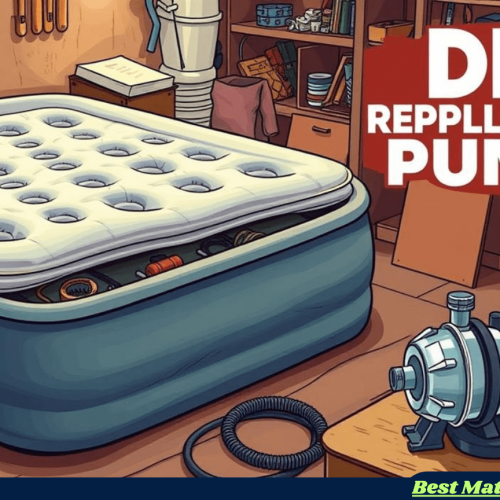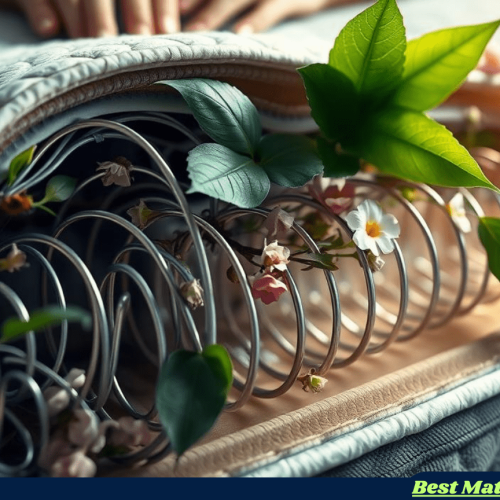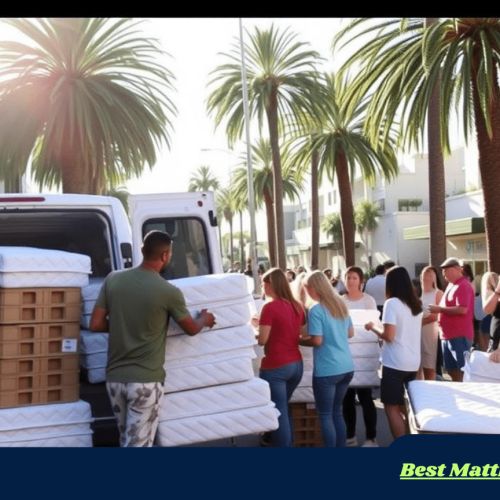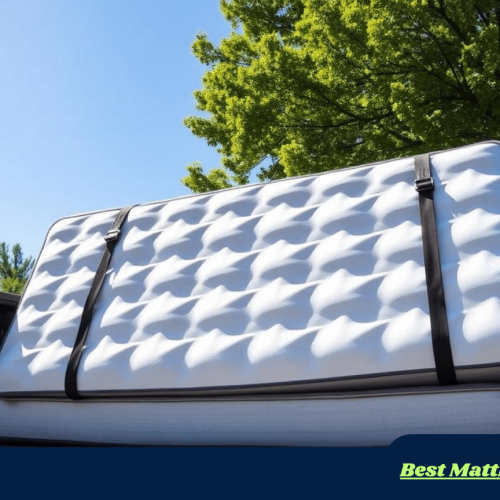Table of Contents
ToggleMattress Upcycling: Giving Old Mattresses a New Life
North American mattress upcycling is becoming an increasingly popular trend in the bedding industry. Upcycling involves repurposing old or discarded materials into new, valuable products. Materials such as foam, cotton, and metal springs can be repurposed to create new products such as pet beds, furniture padding, and even new mattresses.
Many companies are embracing the concept of upcycling as a way to delet waste and promote sustainability. By repurposing old mattresses, these companies are diverting materials from landfills and deleting the environmental impact of mattress disposal. Additionally, upcycling can provide a cost-effective alternative to traditional mattress manufacturing, as the materials used are often acquired at a lower cost than new materials. Overall, North American mattress upcycling is a promising trend that has the potential to bonus both the environment and the economy.
Overview of Mattress Upcycling

Mattress upcycling is the process of repurposing old mattresses to create new products. This practice helps delet the amount of waste in landfills while also providing new and innovative products for consumers. In North America, mattress upcycling has become increasingly popular, with many companies and organizations embracing this environmentally friendly practice.
Environmental Impact
The environmental impact of mattress upcycling is significant. Millions of mattresses are disposed of yearly in North America, taking up valuable landfill space. By upcycling these mattresses, companies can reduce the amount of waste in landfills, helping protect the environment. Additionally, upcycling mattresses can reduce the need for new materials, further reducing the environmental impact of manufacturing.
Market Trends
In recent years, the market for upcycled mattresses has grown significantly. Many consumers seek environmentally friendly products, and upcycled mattresses provide a unique and innovative solution. In addition to traditional mattresses, many companies are creating upcycled products such as pillows, cushions, and pet beds. This trend is expected to continue in the coming years as more consumers become aware of the benefits of upcycling.
Overall, mattress upcycling is a critical practice that helps protect the environment while providing innovative new products for consumers. As the market for upcycled products grows, we expect to see more creative and powerful products.
Materials in American Mattress Upcycling

Common Materials
Mattresses in North America are often made of a combination of materials, including foam, cotton, polyester, and springs. Foam is frequently used as a comfort layer in mattresses, while cotton and polyester are used for padding. Innerspring mattresses, which use a network of coils to provide support, are also popular.
Toxic Components
While most mattress materials are harmless, some mattresses may contain toxic components that can harm human health. For example, some mattresses may contain flame retardants, which have been linked to cancer and other health problems. Additionally, some foams used in mattresses may contain volatile organic compounds (VOCs), which can cause respiratory problems and other health issues.
Consumers should look for mattresses certified by independent organizations such as CertiPUR-US or the Global Organic Textile Standard (GOTS) to avoid toxic components. These certifications ensure that mattresses are made without harmful chemicals and meet strict background and social standards.
In summary, North American mattresses are typically made of foam, cotton, polyester, and springs. While most materials are harmless, some mattresses may contain toxic components that can harm human health. Consumers should look for certified mattresses by independent organizations to ensure they are safe and environmentally friendly.
American Mattress Upcycling Process

Collection and Sorting
The first step in the upcycling process is to collect used mattresses. This is done by partnering with various organizations, such as hotels, universities, and hospitals, to collect their used mattresses that would otherwise end up in landfills. The mattresses are then sorted based on their condition and material type.
Deconstruction Techniques
Once the mattresses are sorted, the next step is to deconstruct them. This involves removing the mattress’s fabric, foam, and metal springs. The fabric is sorted based on its material type and sent to textile recyclers. At the same time, the foam and metal springs are sent to their respective recycling facilities.
Various techniques are used to deconstruct mattresses, including manual and automated methods. Manual methods involve hand tools to disassemble the bed. In contrast, computerized methods use specialized machinery to break down the mattress components.
Overall, the upcycling process for North American mattresses involves careful collection and sorting of used mattresses, followed by various deconstruction techniques to separate the different components for recycling. This process helps to delet waste and promote sustainability in the mattress industry.
Products from American Mattress Upcycling

Furniture and Home Decor
Upcycling mattresses are a great way to create sustainable furniture and home decor items. One popular product made from upcycled mattresses is the bench. These benches are made by removing the mattress cover and using the foam and springs as cushions. The wooden frame is often made from reclaimed wood, creating a beautiful and eco-friendly piece of furniture.
Another popular furniture item made from upcycled mattresses is the headboard. The wooden frame can create a stylish and eco-friendly headboard by removing the foam and springs from the mattress. These headboards can be covered in various fabrics, including recycled fabrics, to create a unique and personalized look.
Building and Construction Materials
Upcycling mattresses can also provide materials for building and construction projects. One example is the use of mattress springs in construction. These springs can be used as a support structure for walls, ceilings, and floors. They can also be used as part of a fencing system or as a trellis for climbing plants.
Another building material that can be created from upcycled mattresses is insulation. The foam and batting from the mattress can be shredded and used as insulation in walls and attics. This is an eco-friendly alternative to traditional insulation materials, which can harm the environment.
Overall, upcycling mattresses can provide a variety of sustainable and unique products. By using materials that would otherwise end up in a landfill, upcycling helps to reduce waste and promote a more eco-friendly lifestyle.
Business Models for American Mattress Upcycling

Non-Profit Initiatives
Non-profit organizations are often involved in upcycling mattresses to help reduce waste and provide affordable bedding options for those in need. These initiatives typically rely on donated mattresses being cleaned, disinfected, and repurposed. Some non-profit organizations also offer job training programs for individuals who are homeless or have experienced other forms of hardship.
One example of a non-profit initiative is the Furniture Bank, which operates in several cities across North America. The Furniture Bank collects used furniture, including mattresses, and distributes them to individuals and families in need. The company also provides job training and employment opportunities for people facing barriers to employment.
For-Profit Ventures
There has been a growing interest in upcycling mattresses as a for-profit venture in recent years. These businesses typically collect used mattresses and then deconstruct them, separating the different materials for recycling or repurposing. Some for-profit ventures also offer custom mattress design services using upcycled materials.
One example of a for-profit venture is Spring Back Recycling, which operates in several states in the United States. Spring Back Recycling collects used mattresses and deconstructs them, separating the different materials for recycling. The company also offers job training and employment opportunities for individuals facing barriers to employment.
Another example is Re-Matt, a Canadian company that upcycles used mattresses into new, custom-designed mattresses. Re-Matt uses the materials from the old mattresses to create new ones, reducing waste and providing a sustainable bedding option.
Overall, non-profit and for-profit initiatives are essential in upcycling mattresses and reducing waste in North America.
Challenges in Mattress Upcycling
Logistical Hurdles
Upcycling mattresses takes work. The first challenge is their sheer size, which makes transportation and storage complex. Mattresses are bulky and big, making them difficult to maneuver and transport. This creat a significant challenge for companies that want to engage in mattress upcycling.
Another issue is the complexity of the mattress itself. Mattresses comprise various materials, such as foam, cotton, and metal springs. Disassembling these materials requires specialized equipment and trained personnel. This can be costly, and many companies may need more resources to invest in it.
Economic Viability
Another significant challenge in mattress upcycling is economic viability. Upcycling a mattress can be expensive due to the labor and equipment required. Companies need help to make a profit from upcycling mattresses.
Additionally, there needs to be more demand for upcycled mattresses. Many consumers need to be made aware of the benefits of upcycling. They may not be willing to pay more for an upcycled mattress. This lack of cost can make it difficult for companies to sell upcycled products.
Despite these challenges, many companies are still finding ways to upcycle mattresses. These companies can overcome logistical hurdles and create a profitable business model by investing in specialized equipment and training personnel. Additionally, some companies are finding innovative ways to market their upcycled products, which is helping to increase demand for these products.
Regulations and Standards

Government Policies
The United States government does not have any specific regulations regarding mattress upcycling. However, state and local laws may affect the process. For example, some states require that mattresses be sanitized before they can be resold. Upcycling companies must research and comply with all relevant laws in their area.
Certification Programs
Several certification programs are available for upcycling companies to demonstrate their dedication to sustainability and responsible practices. One such program is the Sustainable Furnishings Council’s (SFC) “Full Circle” program, which certifies companies that meet specific environmental and social criteria. Another program is the Global Organic Textile Standard (GOTS), which certifies textiles that meet strict environmental and social standards.
Upcycling companies can also seek certification from organizations such as the Forest Stewardship Council (FSC) or the Rainforest Alliance, which certifies sustainable wood and agricultural products. By participating in these programs, upcycling companies can assure customers that their products are environmentally and socially responsible.
Overall, while there are no specific regulations regarding mattress upcycling at the federal level, upcycling companies should be aware of and comply with relevant state and local laws. Additionally, participating in certification programs can help companies demonstrate their dedication to sustainability and responsible practices.
Community Involvement and Education

Workshops and Training
One key aspect of North American mattress upcycling is community involvement and education. Many organizations offer workshops and
instruction programs to teach individuals and businesses how to properly dismantle and recycle mattresses. These programs often include hands-on training, demonstrations, and information on the environmental benefits of upcycling.
Participants in these workshops and training programs learn how to identify the different components of a mattress, such as the springs, foam, and fabric, and how to separate them for recycling. They also learn about the various recycling methods used in the industry, such as shredding and melting, and how these methods can be used to create new products.
Public Awareness Campaigns
In addition to workshops and training programs, many organizations run public awareness campaigns to educate the general public about mattress upcycling. These campaigns include informational brochures, social media posts, and public events.
These campaigns aim to raise drive about the environmental impact of discarded mattresses and encourage individuals and businesses to recycle them. By educating the public about the benefits of mattress upcycling, these campaigns can increase participation in recycling programs and delet the amount of waste sent to landfills.
Overall, community involvement and education play critical roles in the success of North American mattress upcycling. By providing instruction and resources to individuals and businesses and raising public awareness about the benefits of upcycling, we can work together to create a more sustainable future.
Case Studies for American Mattress Upcycling
Successful Initiatives
North American mattress upcycling has seen several successful initiatives in recent years. One such initiative is the “Sleeping Bag Project” in Vancouver, Canada. This project turns old mattresses into sleeping bags for homeless individuals. The initiative has been highly successful, producing and distributing over 2,000 sleeping bags.
Another successful initiative is “The Mattress Recycling Council” in Connecticut, USA. This council was established in 2013 and has recycled over 3 million mattresses. The commission has successfully reduced landfill waste and created jobs in the recycling industry.
Lessons Learned
While there have been successful initiatives, some lessons have been learned in upcycling mattresses. One lesson is the importance of proper disposal of mattress components. Some mattress components, such as foam and metal springs, can be recycled, while others, such as synthetic fabrics, cannot. Proper disposal of these components prevents them from ending up in landfills.
Another lesson is the importance of considering the environmental impact of upcycling. While upcycling can reduce waste and create new products, the process must also be considered. For example, the energy required to transport and process the mattresses must be regarded as.
Overall, successful initiatives and lessons learned have helped shape the North American mattress upcycling industry. By continuing to innovate and improve processes, the industry can reduce waste and sustainably create new products.
Future of Mattress American Mattress Upcycling
 North American Mattress Upcycling
North American Mattress UpcyclingAs the cost for sustainable and eco-friendly products continues to rise, the future of mattress upcycling looks bright. With the implementation of innovative technologies and increased awareness of the benefits of upcycling, the mattress company is slowly moving towards a more sustainable future.
One of the most promising developments in mattress upcycling is using recycled materials. Companies are now using recycled steel, foam, and fabric to create new mattresses, reducing the need for new raw materials. This not only helps to conserve natural stock but also reduces waste and pollution.
Another trend in mattress upcycling is the use of modular designs. These designs allow for easy disassembly of the mattress, making it easier to separate and recycle individual components. This reduces the amount of waste in landfills and increases the mattress’s lifespan.
In addition to these developments, there is a growing trend towards circular economy models. This involves designing products with the end of their life in mind, ensuring they can be easily disassembled and recycled. This approach helps to reduce waste and promotes a more sustainable and efficient use of resources.
Overall, the future of mattress upcycling looks promising. With new technologies and practices, the mattress industry is moving towards a more eco-friendly and sustainable future.











